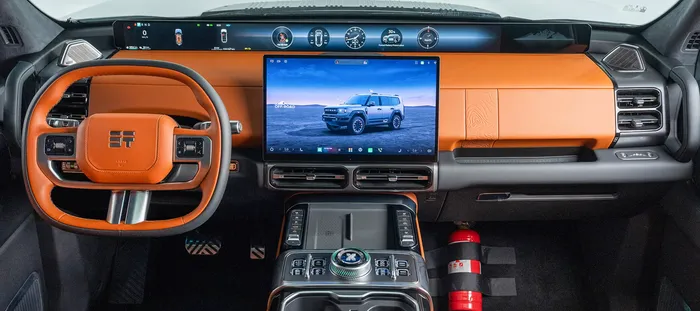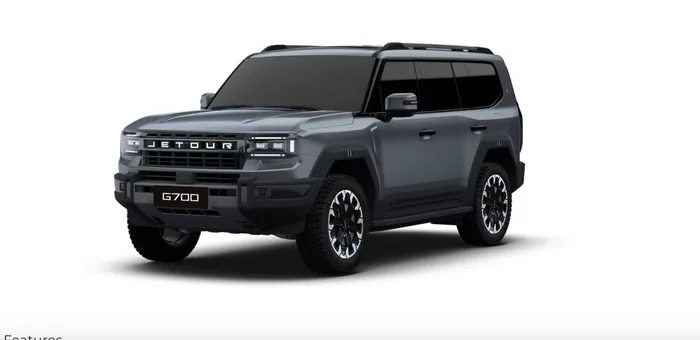
.
Image: Jetour
When Jetour unveiled its new G700 plug-in hybrid earlier this month, the Chinese automaker didn't just promise more range or horsepower; it promised a car that could leave the road behind, and keep going.
In a dramatic demonstration last week, the G700 powered through a remote mountain pass in minutes, climbing loose rock and crossing rain-swelled streams without pause.
At its core, the G700 is built around an advanced hybrid powertrain and 4WD system designed for severe terrain. The driving system integrates a 2.0-litre turbocharged petrol engine with dual electric motors, coordinated via multi-plate clutches and electronic differential locks.
The vehicle uses an intelligent all-wheel-drive architecture (XWD) that monitors wheel slip, surface conditions and camber in real time, and allocates drive torque accordingly to maintain traction.
Underneath the vehicle, the chassis has been engineered to handle adverse conditions: a sealed underbody, a reinforced battery housing and a reported wading depth of 970 mm ensure the G700 can traverse water, silt and dirt without compromising its core systems.
The driver interface supports a 14-mode terrain dial covering “Water / Rock / Sand / Mud” selections, allowing the vehicle’s software to map behaviour to the chosen terrain. The manufacturer describes this as more than just off-road hardware; it is designed for sustained mobility in places where roads vanish.
In terms of propulsion, the hybrid system’s claimed figures are substantial: around 904 hp (approximately 665 kW) and 1,135 Nm of torque, powered in part by a 31.4 kWh battery pack from CATL.
That battery enables a pure-electric range of roughly 150 km (under China’s CLTC cycle) and, with both fuel tank and battery full, a combined range of up to 1,400 km. Fast-charging capability is claimed: a charge from 20-80 % in about 10 minutes with an ultra-fast charger.
Crucially, the vehicle’s off-road system doesn’t simply send power to all wheels and hope for the best; the torque vectoring capability means the software can send or withhold power to any individual axle or wheel.
This allows the vehicle not just to climb obstacles, but to calculate the “smartest” way up them. The same suite of sensors that detects camber and wheel slip on a rock face can maintain a stable heading through white-out conditions or a rock-strewn riverbed. While it’s not a fully autonomous off-roader, the level of semi-autonomous terrain control is unusual in a consumer SUV.
Additional specifications reveal that the G700 uses a ladder-frame (body-on-frame) architecture, air suspension, three differential locks (in certain trims) and approach/departure angles designed for serious terrain: for example, an approach angle of 28–35°, and a departure angle of 25–30°, depending on version.
Ground clearance is around 320 mm; towing capacity is rated at 2,500 kg.
The amphibious credentials include the ability to wade up to 970mm depth for up to 40 minutes in water currents as strong as 5 m/s, while maintaining cabin integrity.
The interior also plays a role in the tech story: large-format displays (e.g., a 35.4-inch dash display, 15.6-inch infotainment screen) and physical switchgear designed for off-road use reflect the ambition to merge ruggedness with modern digital capability. The infotainment and driver-assistance systems align with the vehicle’s terrain capability, rather than remaining purely luxury features.

.
Image: Jetour
Jetour isn’t pitching the G700 as a boutique trail toy. From its built-in oxygen generator (3 L/min for thin-air camps or post-disaster zones) to its vehicle-to-load outlet that can run field medical gear, the SUV is aimed at drivers who want one machine for the daily commute, the weekend escape and the emergency.
If the G700 succeeds, it could spark a new class of “go-anywhere hybrids,” machines equally at home in the school-run traffic circle, the high-plateau campsite or the storm-cut service road.
And while most drivers may never need every extreme feature, the symbolism is clear: in an age of climate disruption, the ultimate luxury isn’t chrome or leather, it’s the confidence to keep going.
FAST COMPANY
